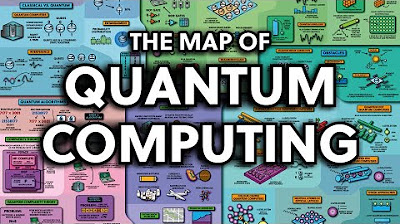mod02lec12 - Quantum Computing Concepts: Entanglement and Interference - Part 2
Summary
TLDRThis educational video script delves into the quantum mechanics principles of superposition, entanglement, and interference, crucial for quantum computing. It explains quantum teleportation, emphasizing its reliance on classical communication channels due to the no-cloning theorem. The script also touches on the no-cloning theorem, which prohibits the duplication of arbitrary qubits, and the potential of algorithms like Grover's, which utilizes quantum interference. The lecture aims to transition from theory to practical application, guiding viewers on creating quantum circuits and programming with Qiskit.
Takeaways
- 🧬 **Quantum Teleportation Basics**: The script explains the concept of quantum teleportation, where a qubit's state is transferred from one location to another using entanglement and classical communication.
- 🔄 **Transformations in Teleportation**: It details how Bob must apply bit flips and phase flips (using Pauli X and Z gates) to recover the original state based on Alice's measurements.
- 🔗 **Entanglement Swapping**: The script introduces entanglement swapping, a process where entanglement is transferred between parties to create a new entangled pair.
- 🚫 **No-Cloning Theorem**: It emphasizes the no-cloning theorem in quantum computing, which states that it's impossible to create an identical copy of an arbitrary unknown quantum state.
- 🌐 **Quantum vs Classical Communication**: The script clarifies that while quantum teleportation is instantaneous at the quantum level, the classical communication of measurement results is limited by the speed of light.
- 🌌 **Experimental Verification**: Quantum teleportation has been experimentally verified, with examples including teleportation from the ground to a satellite and between islands.
- ⚛️ **Quantum Gates and Operations**: The script discusses how quantum gates like the Hadamard gate can create superpositions, and how these gates are used in combination to perform quantum computations.
- 🌟 **Interference in Quantum Computing**: It explains how interference, a wave-like property, is used in quantum algorithms to amplify correct answers and diminish incorrect ones.
- 🛠️ **Building Quantum Algorithms**: The process of constructing quantum algorithms involves determining state space, applying transformations, and using entanglement and interference to solve problems.
- 📚 **Practical Application**: The script concludes by encouraging the application of theoretical knowledge to practical exercises and programming on real quantum computers using frameworks like Qiskit.
Q & A
What is the significance of the state 'phi' in quantum teleportation as described in the script?
-In quantum teleportation, 'phi' represents the qubit state that Alice wants to transmit to Bob. Bob needs to perform certain transformations based on Alice's measurements to recreate the original state 'phi' on his end.
How does Bob recover the original qubit state sent by Alice if he receives the bit '01' from her?
-If Bob receives '01' from Alice, he needs to perform a bit flip on his state to change it from 'alpha_1 + beta_0' to 'alpha_0 + beta_1', which corresponds to the desired state '5'.
What quantum gate is used to perform a phase flip in the context of quantum teleportation?
-A phase flip in quantum teleportation is performed using the Pauli-Z gate, often denoted as Z gate.
What is entanglement swapping and how is it achieved?
-Entanglement swapping is a process that allows two parties who do not share an entangled state to become entangled through a series of quantum operations involving previously shared entangled states. It is achieved by using the teleportation protocol.
What is the no-cloning theorem in quantum computing, and why is it important?
-The no-cloning theorem states that it is impossible to create an identical copy of an arbitrary unknown quantum state. This is important because it ensures the security of quantum information and sets a fundamental difference between quantum and classical computing.
Why can't a CNOT gate be used to copy an arbitrary qubit?
-A CNOT gate cannot be used to copy an arbitrary qubit because it would require the second qubit to be in the same state as the first, which contradicts the principle that the output of the XOR operation (CNOT) must equal the first qubit.
How does interference play a role in quantum computing?
-Interference in quantum computing is used to amplify certain states and diminish others by applying suitable phase changes. This is crucial in algorithms like Grover's algorithm, where interference is used to increase the probability of the correct answer.
What is the purpose of the Hadamard gate in the context of quantum algorithms?
-The Hadamard gate is used in quantum algorithms to create an equal superposition of states. By applying the Hadamard gate to each qubit, the system enters a state of superposition, which is a prerequisite for many quantum algorithms.
How does the measurement process in a quantum system relate to the superposition state?
-In a quantum system, measurement collapses the superposition state to a definite state. To understand the superposition state, one must perform multiple measurements and analyze the probability distribution of the outcomes.
What is the role of the IBM Quantum Experience in learning quantum computing?
-The IBM Quantum Experience provides a platform where users can create and run quantum circuits on real quantum computers. It is an essential tool for learning and experimenting with quantum computing algorithms.
Outlines

此内容仅限付费用户访问。 请升级后访问。
立即升级Mindmap

此内容仅限付费用户访问。 请升级后访问。
立即升级Keywords

此内容仅限付费用户访问。 请升级后访问。
立即升级Highlights

此内容仅限付费用户访问。 请升级后访问。
立即升级Transcripts

此内容仅限付费用户访问。 请升级后访问。
立即升级浏览更多相关视频

The Map of Quantum Computing - Quantum Computing Explained

Quantum Computing: What, Why, and What for

Quantum Computing Expert Explains One Concept in 5 Levels of Difficulty | WIRED

Quantum Mechanics for Dummies

Quantum Computers: Explained VISUALLY

What can Schrödinger's cat teach us about quantum mechanics? - Josh Samani
5.0 / 5 (0 votes)
